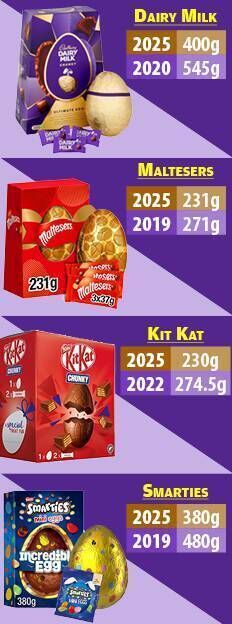In just four short years, the price of Easter eggs has increased by at least a third, and that’s not the full picture for Irish consumers either. If you’re planning an Easter egg-stravaganza in the coming fortnight you may find it costing you quite a bit more than it used to.
Recently, when checking my references for the price of eggs, I discovered that large chocolate eggs were selling 3-for-€5 in 2021.
This week they’re priced at 4-for-€10. Effectively making it a third more expensive to buy the same brand eggs in 2025, than it was in 2021.
The price consumers pay at the till is only part of a value equation and unfortunately when it comes to chocolate, the bad news doesn’t stop there.
Shrinkflation is the practice of reducing the size of a product, while maintaining the same price and/or packaging in order to retain more profits for the manufacturer.
In this way, chocolate companies can continue to earn strong profits by making a slightly smaller egg but continuing to charge the price for a larger Easter treat. At scale, this all adds up to claw back a higher profit margin for the producer.
As of this week, the price of cocoa, a key ingredient in the manufacture of chocolate, is trading lower than it was this time last year on the global market. That’s a little too late for Easter egg manufacturers though, who would have bought and started to make chocolates for this April in 2024.
Approximately 50% of the world's cocoa is grown by small farmers in West Africa, specifically Cote D’Ivoire and Ghana and these areas are particularly vulnerable to climate change.
As cocoa plants are so sensitive to increased temperatures with plants have a three to four-year life cycle, high temperatures over several years have decimated the crop. Even cocoa plants that do thrive may not produce high quality cocoa pods that we are used to.
As climate change continues at pace, the rate at which the crops are failing is accelerating. Moving the plants to higher, cooler areas also comes at a cost and is no quick fix.
If you think that modern chocolate doesn’t taste anything like it used to in your childhood, you’d be right. To start with, the quality of the chocolate products we buy in the supermarket is on the decline.
Some manufacturers use more palm oil or vegetable oil in the ingredients to compensate for poor cocoa quality. Others decrease the cocoa volume in their bars and bulk this up with more sugar or sweeteners.

As we age, our tastebuds change and our preferences also alter. If I had been handed a piece of dark chocolate aged 10, I would have thought it incredibly bitter and unpleasant, now I’m a dark chocolate convert who appreciates the flavour complexities.
There are other items that add to the price we pay on the shelf such as transport, packaging, and higher labour costs. Even though these make us feel more pinched at the checkout, I’m sure that most consumers are happy to know that workers are paid a fair wage, the chocolate is wrapped in recyclable packaging and the chocolate has come from an ethical source.
Back to those Easter egg special offers, that this year are a third more expensive than four years ago. While special offers are discounted prices and don’t reflect the normal price on an item on the shelf, it’s also difficult to review like-for-like because the clever chocolate companies alter and tailor the individual egg offerings from year-to-year depending on consumer’s demands. For example, Dubai Chocolate is the headline food trend at the moment and this has translated to pistachio-themed Easter eggs for the second year running.
I can tell you that the size of Easter eggs has been slowly decreasing in the past couple of years. For example, between 2022 and 2025, the size of a Kit Kat egg decreased by 44.5g, and again with an economy of scale there are considerable savings there for the producer to be made.
There are some exceptions to the rule of diminishing sizes though, with Lindt Lindor Milk Truffle Egg weighing exactly the same as in 2021, but costing over €7 more to buy in 2025 in the space of four years. Clearly, some of us are prepared to pay a premium for the chocolate we love.
In good news, manufacturers are experimenting with the use of alternative ingredients to replace costly chocolate in the future.
The “Taste of Tomorrow” exhibition currently in London explores how cocoa-free chocolate can be crafted from fava beans (dried broad beans).
I’m not sure if dedicated chocaholics like me are ready to give up their precious chocolate just yet, but we will certainly have to get used to paying higher prices for a potentially lower quality product.
CONNECT WITH US TODAY
Be the first to know the latest news and updates








